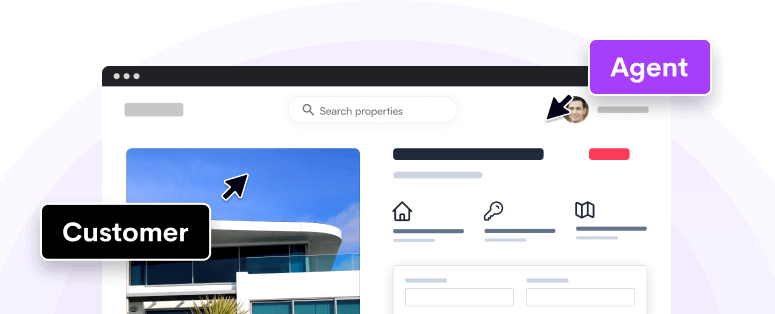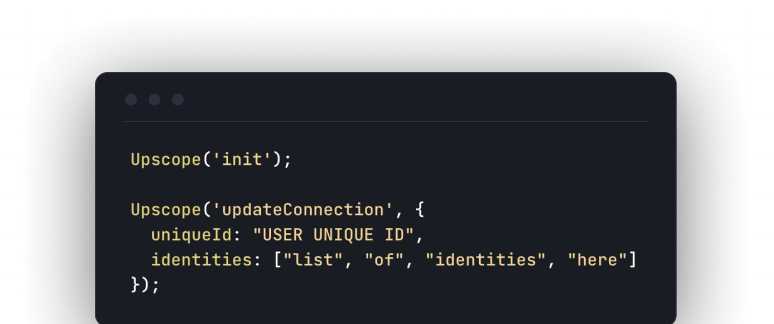You'll go slightly crazy choosing how to onboard and train employees and
customers on software because it requires swimming through abbreviations like
DAP, LMS, Internal KB and terms like Corporate Wiki. Below we'll clarify some
these terms and focus on DAPs (Digital Adopt Platforms) as an advanced
practical method with the greatest potential. A DAP has the simple advantage
of teaching directly on the page through doing and has a lot of evolution
ahead of it.
Key questions we'll cover
How many SaaS cloud apps are companies now using?
What sort of problems does having so many SaaS apps create?
What training and onboarding problems does this software create?
How are companies onboarding and training people?
What major groupings of services are used to train and onboard customers and
employees onto software?
What types of Digital Adoption Platforms are there? What do they do?
What's going to happen next? What's the likely evolution?
How many cloud apps are companies now using?
At Upscope we use anywhere between 20 to 30 cloud apps. I'm personally using
Gmail, SEMRush, Intercom, Vitally, Notion, Slack, Ghost, RoamResearch,
Hubspot, Upscope itself, Anymailfinder, Angellist, Heroku, Github, Oribi,
Blazer and I'm probably forgetting another half a dozen.
Soon I'll also be using software for SOC2 certification management, product
management, recruitment and any process which can be handled better by a
system rather than a Google Sheet. In some ways most apps are just a
replacement for inane things we do on Sheets and Docs.
Blissfully's report on app usage
Below are statistics from Blissfully as a good overview of what's happening
within a range of different sized organisations.
"In 2019, 68% of organizations said they are mostly or all SaaS-driven at this
point, with nearly 23% saying they operate solely using SaaS apps today"
"Overall spend per company on SaaS products is up 50%,"
"The number of billing owners per company has increased from 12 in 2019 to 21
in our 2020 report"
"The unique number of apps in usage per company is up about 30% year over
year, with companies averaging 137 in 2019 vs. 2018"
"The average small business uses 102 different apps, while each mid-market
business uses an average of 137 apps. Enterprises have, on average, 288
different SaaS apps in usage across their businesses"
The report by Blisfully was published in Oct 2019 so take into account
that spending on SaaS has likely rocketed since then due to the pandemic
forcing organisations to go cloud first.
See the blissfully report on SaaS trends
here.
Okta have proven statistics on company cloud usage
Okta is a service companies use to securely access their own applications and
is likely used on most of the apps within a given company. This means they'll
have accurate minimum usage data on SaaS apps companies use.
Note, they define big companies as being over 2,000 and small firms as being
under 2,000.
"The number of software apps deployed by large firms across all industries
world-wide has increased 68% over the past four years, reaching an average of
129 apps per company by the end of 2018"
"Nearly 10% of businesses now have more than 200 apps in their enterprise
information-technology systems, the San Francisco-based identity-management
firm said in a report Thursday. The report defines large firms as having
more than 2,000 employees and small firms as having fewer than 2,000."
"It found smaller firms tended to have fewer apps, though the average number
is also rising—jumping from 53 in 2015, to 73 last year."
The next point is interesting because at Upscope we've been specifically told,
during sales calls, that they're taking up our system so they don't become
reliant on some all-in-one solution.
"The business world’s growing appetite for apps showcases the move over the
last 10 years from single vendors with all-in-one platforms to “best-of-breed”
applications."
This is partly due to control but also the realisation that a company focusing
on developing one application is likely to build a better app than a company
building multiple applications into a big all-in-one solution. They'll never
refine and perfect the app like a more focused organisation where the
investment in getting it right comes from the very top of the company.
Read more on Okta's numbers
here.
Chief Martech put it at 1,295 cloud services per enterprise
Here's a nice table summary of where these apps are used. I'd expect
development tools to rise up this list over time as it's a huge growing market
and the competitors are flooding in. Not a bad thing at all :)

"As you can see in the chart at the top of this post, the latest data
available from Netskope’s 2019 Cloud
Report
shows that the average enterprise is using 1,295 cloud services — a number
that keeps rising, year over year."
Data from Chief
Martech.
What sort of problems does having so many SaaS apps create?
Security
“Organizations are shifting the focus of modern security away from traditional
network strategies to perimeter-less approaches, focusing on users, data, and
locations."
"Privacy, security and lack of staff training are the top roadblocks to cloud
adoption."
There's one interesting point from the WSJ / Okta article worth thinking
about. The companies are both swamped by SaaS apps but also encouraging their
use. They want to eliminate unnecessary clutter but also not discourage people
from using new apps. Huge enterprises have the same dilemma as small ones.
SaaS apps help productivity and ground up adoption is a common path to
realising that productivity gain. You can't stop that with a top down policy
restricting everything.
Read the WSJ Okta article
here.
The SaaS Sprawl
There's even a term for this expansion of apps. It's called the "SaaS Sprawl".
Application sprawl and shadow IT can lead to:
-
Data loss or a data breach
-
Inefficient collaboration amongst teams
-
Compliance concerns
-
Bandwidth limitations
-
Wasted budget spend on SaaS applications
-
Overlapping software subscriptions in the public cloud
-
Different teams using different software that offers the same features
-
Paying for more features than what is needed
-
Buying SaaS applications before they’re needed
See more on SaaS Sprawl in this G2 article
here.
Administering and deploying apps
It is often challenging to apply best practices for configuration management
in SaaS environments because:
-
The application may be supported by business, not IT.
-
SaaS administrators may not be familiar with configuration and release
management practices. -
SaaS deployment tools are still maturing.
-
Deploying an application often requires both manual and automated steps.
-
SaaS integrations require synching releases with legacy systems.
-
Code, configuration, deployment scripts and manual checklists all need to be
checked into the source code repository.
Read more from
CIO.com
Okta's top SaaS sprawl challenges faced by companies
-
Password fatigue, provision and de-provision. they have to rely on app
administrators to remember to remove access. So needs automated
de-provisioning, clear audit trails, integration with active directory. -
Compliance visibility for auditors. Who has access to what.
-
"These solutions are often managed by the corresponding functional area in a
company, such as the Sales Operations group in the case of Salesforce.com.
This can benefit IT but it can also create a new problem because there is no
central place to manage users and applications, or provide reports and
analytics." -
Siloed data is a problem. You can have e.g. a Marketing department spread
across multiple countries but each location uses it's own unique app and data
storage structure so it's harder to get an overall picture. "Companies all
have a myriad of systems that don’t necessarily integrate with one another.
With this network of systems that do not cooperate it becomes difficult to
share
data
across departments. Exacerbating this problem is an increasingly distributed
workforce. If an audit team in North America uses one system, but a team in
Europe uses a different system, the data from those systems will end up in
silos."
Read more from Okta
here.
Time wasted bouncing around between apps
"73% spend more than 1 hour per day on average navigating from app to app.
With 100 billable resources on a team at $150/hour, that’s $15k lost in
potential revenue per day. 72% say data quality as a top BI challenge -
meaning companies are working with unreliable data."
"All companies need a number of systems to operate effectively. The issue is
that some of these systems work together and some don’t. Because these systems
don’t talk to one another, the company isn’t really operating optimally.
Adding to the problem is the fact that many organizations even have duplicate
systems in use by different departments."
Read more from app developer magazine
here.
People abandon SaaS apps expecting them to be iPhone smooth
An almost comical underlying problem is that after using an iPhone and similar
consumer software we expect business apps to be just as easy to use. It's a
big CX problem
where even companies that build elevators are finding customers want tracking
apps to see how the build is progressing almost as if it's an Amazon delivery
they want to track on their phone.
“Employees have shown a profound ability to use consumer tools to discover and
assess information, collaborate, network and carry out tasks in their personal
lives. The tools they have at work should be on par with, if not leagues ahead
of the consumer apps they can use outside of work”
"The traditional utilitarian structure of enterprise apps often leaves users
uninterested and easily distracted. When workers are used to seamless
consumer apps, they have a hard time working with clunky and inefficient
platforms."
"Custom-tailored software and processes will help employees get work done
faster so they can service more customers better. And accomplishing this with
no-code tools makes the task profoundly possible.”
From CIO article on SaaS
abandonment
Training and onboarding problems
The key problem of course is training and onboarding. Not only do they need to
understand and get to work with a range of apps but ideally it's again iPhone
smooth and simple.
Onboarding new team members on apps at Upscope as we expand is a massive
concern. We don't want to repeat the same introductory talk again and again
and I don't think new team members want to sit through pained instruction. The
initial talk is often forgotten anyway. Seeing and doing things in practise
with documentation as backup is preferable.
ProfitWell describe some of the key problems in training.
"A complex SaaS product is rarely intuitive. It may require SaaS certification and training. Not too many SaaS providers offer such training, leaving many users in the dark."
"Some SaaS users don't learn how to use the entire functionality simply
because they aren't aware of it. They pay for a product to use its key
features without paying any attention to what else it has to offer."
The above is painfully true. I know that the service SEMRush has some
brilliant features but learning about them would involve going through some
dreaded videos and tutorials and I'd need to repeatedly refer back to the
software to test them as I'm watching. Ideally the help should be on the page
but there are solutions for that as we'll see further below when we discuss
Digital Adoption Platforms.
"When users receive official SaaS certifications, they are more likely to
become brand ambassadors. Official training adds credibility to the holder of
the certificate, and then by extension, to the app itself."
"Online communities and in-person training build and strengthen your network
of users. This brings credibility to your company, provides opportunities for
product feature developments through customer feedback, turns customers into
brand ambassadors, and much more."
See more on Profitwell's SaaS training and
certification.
Workable describe employee onboarding steps
Here's a great reminder from Workable about how much is involved in onboarding
a new employee:
-
Set up employees online accounts including email, instant message, password
mgt, productivity, -
Get them laptop, phone, monitor, mouse, keyboard, headset, phone number,
-
Introductory meetings with new colleagues over first few weeks
-
Plan first assignment
-
Day before first day: Technology setup instructions. copy of org charg. copy
of first week schedule. copy of team culture book. -
On first day: Allow your new hire some downtime to set up their new
equipment, set new passwords and log in to their new accounts. -
During first week. Have 1 to 1 meetings. Give 3 month road map.
-
After onboarding - ask for feedback
In between all that they'll be learning about apps and getting used to the
culture and environment. Are they going to retain all that information? It's
quite a head rush. Those internal wiki's, knowledge bases, LMS and DAP systems
have quite a role to play here in helping with both general onboarding but
specifically with apps they may be spending 95% of their time on. Read more on
them further below.
Read more on Workable's employee
onboarding.
Oracle describes how formal training is forgotten in a week
Oracle nail the problems with training in the modern SaaS environment. There's
not enough time allocated for training and yet, because people want business
apps to be consumer app smart and smooth and immediate, the trainees are
impatient. Finally, with Slack going dut-dut-dut every 3.5 minutes with new
information, tasks, reports and jokes, it's harder to focus.
Overwhelmed and short on time – during a typical work week, employees can
only dedicate 1% of their time to training and development; just 24 minutes
Impatient for knowledge – learners do not have time to wait for scheduled
courses; they are looking to solve an immediate business problem
Distracted with constant interruptions, and overloaded with information –
80% of formal training is forgotten within a week
See more on this by Oracle
here.
What types of services are used to train employees and customers on using
software?
You've got an array of options to onboard and train people on software. This
includes Learning Management Systems (LMS) and Digital Adoption Platforms
(DAP) which may or may not integrate with an LMS. There are internal knowledge
bases sometimes shortened to Internal KB, Corporate Wiki's that can overlap
functions with a CMS (Content Management System) which itself could partly be
replicated in that Internal KB.
Here's a rapid overview of most of the above. I'll skip content management
systems as the variety of CMS out there will complicate matters even further.
Digital Adoption Platforms (DAP)

Whatfix allow you to create software tours with explanatory
tooltips
Ever sign up for a new website and have it take you on a tour of the software
by highlighting buttons and showing little explanatory tips next to it?
That's a DAP at work. Companies like Walkme, Whatfix, Toonimo, Apty, Appcues
are some examples of DAPs.
The tours they provide can be used on internal app training and customer
onboarding.
An enterprise might buy a software like Salesforce and follow an onboarding
flow to learn about it but after implementing that software they may need to
create their own internal tour in using that software.
Why?
Something like Salesforce has so many integrations that after purchase a
company needs to create a new tour explaining to new employees how to use
Salesforce for that company's own unique and extensive custom implementation.
Also, the code works between apps in some instances. You can have a process
stretching across Salesforce and Workday where (assuming the DAP integration
works with both) the tour starts at Salesforce and smoothly transitions to
Workday and finishes there, showing you a complete cross-departmental process.
Learning Management Systems (LMS)

is one example of a Learning Management System allowing you to create
courses
While the DAP sits on your application guiding you, it does not have courses,
quizzes, points, badges, leaderboards or full on tracking and reporting for
the specific purpose of evaluating progress and providing feedback. An LMS
does this.
Using an LMS you can build a course, add quizzes, tests, videos and images to
help explain not only software in but help people learn about real estate,
supply chain procedures, compliance with regulation within aviation, and sales
processes within dealerships.
What's interesting is that many DAP solutions mention being able to connect to
an LMS which makes sense. Completing an initial onboarding flow that shows you
how to use a software is not proof that you understand a software. We're
likely to forget most of it a week later. The LMS would help reinforce and
institute that learning.
Internal Knowledge Bases (Internal KB)

There's some overlap between an internal KB and a corporate wiki but the key
difference is that the internal KB is primarily passive.
It's written once and occasionally updated. It's intended to be read and acted
on the same way a help centre allows customers to search for instructions to
understand a software or overcome a problem.
In fact, help centres and internal KBs look alike, as I imagine some companies
built an external customer facing knowledge base to sell and then used the
same tech to provide an internal KB for employees once they saw the demand.
An internal KB is where employees go when they have a question. It might
include office addresses, benefits, tech help, org structure etc.
Corporate Wikis

While the knowledge base might contain the more formal docs that will provide
onboarding material for new employees and provide answers to existing
employees, a corporate wiki is the centralised search point for a lot of
knowledge that might be regularly updated and added to.
The corporate wiki might have documents on processes, projects, products,
quarterly meetings, internal product updates, changes to financial schemes and
more.
A corporate wiki might contain some passive data but a lot of it will dynamic,
regularly updated and conversational.

is a popular corporate wiki
As an example, a marketing team might use it for holding and updating product
messaging, personas, competitor battle cards, product launch checklist,
branding guidelines, and a marketing strategy framework. This will of course
change regularly and be referred to regularly rather than a once in 3 months
visit to the internal KB.
What types of Digital Adoption Platforms are there? What do they do?
Not only the path of least resistance but the also practical time saving value
of learning on the live website means Digital Adoption Platforms are worth
focusing on.
They don't cover ALL the features of an LMS, Internal KB or Corporate Wiki but
they have a chance to evolve into a solution covering many features of both
the LMS and Internal KB by bringing those features directly onto the page and
within the action.
We'll see why by covering a few of the popular systems out there.
Whatfix
While you already know roughly how a DAP works, it's the differences and
similarities between them that give us insights.

For example, Whatfix.com, like a few other DAPs, has a Salesforce overlay and
integration.
Several companies do this and having used Salesforce I can understand why.
It's useful for Salesforce to onboard customers but many of the solutions are
for onboarding internal employees onto that company's Salesforce solution and
then they connect over to other applications, like Workday for
cross-application tours.

The above is the Whatfix navigation menu and similar entries are found in a
number of DAP menus showing how they tend to cover both user onboarding and
employee onboarding, as well as a focus on CRMs.
CRMs probably have the highest learning curve, especially for custom
implementations, and are naturally numbers 1, 2 and 3 on the platforms list
above.
Apty
As a comparison here is Apty's navigation menu.

There's quite an overlap with Whatfix.
The obvious thing to mention is the size of Salesforce, Dynamics and Oracle.
If you build a solution for just 1% of Salesforce, that is still a $1bn
market.
Collectively these CRMs make up an incredible total percentage of the market
and their combined value is in the 100s of billions. So yes, I full appreciate
why companies focus their solutions on them.

Apty, like a few others, also mentions SCORM objects. "With Apty, you can
quickly export your workflows into articles, videos, slides, or SCORM
objects."
This appears to be a way to connect a DAP to a Learning Management System that
carries on into more in-depth training. That said, the companies building the
DAP solutions are not far off from providing that functionality themselves and
there's some overlap already.
Pendo
Pendo.io seems like an analytics and feedback tool that became a DAP
afterwards but I can't say I know its history. However, Pendo is unique.
Pendo focuses on analytics, sentiment, feedback, roadmaps along with user walk
throughs. It's almost like a UX analytics, Customer Success and Product
Management app combined with a DAP.
This shows how many different directions DAPs can go and how they reach across
departments.

Like the others they cover both user and internal onboarding and training.
They also provide a white-label solution called "Pendo Adopt".
"Pendo Adopt is a whitelabel in-application training product. Each
customer uses your product differently, with unique roles, procedures, and
conventions. With Pendo Adopt, your customers can document specific training
and guidance for their users, and monitor compliance."
So, they're selling their adoption product to companies to sell to their
customers who would then use it for their customers. It's a little mind
stretching but you can see how big a market this is. One of their customers is
AWS!
Toonimo
Now for something completely different.
Toonimo.com has quite an impact when you first try out their
demo.

What happens?
A popup appears asking if you need help filling out the form. This is quite
normal with DAPs but then...
... it starts talking to you, loud and clear to give you instructions on
filling out the form. You're now watching buttons become highlighted as a
voice talks to you about what each button will do.
This is another evolution of DAP systems. Voice and likely video that talks
you through the form as you fill it in. I don't think you always need voice
and video but it's almost comforting to hear a voice giving you a rapid intro
to something if you're not sure about it. That can develop into all sorts of
useful guidance.
Thought Industries
I've picked this one out because of Thought
Industries'
interesting side bar.

The one thing I worry about with DAPs is "Who is going to maintain it?" and
"How often does it break" due to a user interface change?
DAPs have ways of managing breaks whereby it adapts or warns the creator of
the broken flow but I'd be worrying if consumers or employees are following
some old broken flow. On top of which it takes months to implement systems.
Do DAPs really need to identify the exact button to click? Or can they give a
more general explanation on a side bar instead and let the person build some
muscle memory in figuring it out themselves?
Personally, I go to sleep following instructions from DAPs. It does help me
get from point A to point B and see what a software does but it's not sinking
in. It could be due to the way it was implemented but sometimes I just want
some general guidance on what to do next. A side bar could well do 80% of the
work without the maintenance hassle.
GetGuru, the corporate wiki, mentions this maintenance problem and offers a
solution by having a system of Verifiers:
"One of the most important parts of onboarding is ensuring that the knowledge
new hires are consuming is up to date. If your onboarding program includes an
old version of your slide or materials from before your last brand refresh,
your new hires will be assimilating themselves with the wrong knowledge. Every
piece of knowledge in Guru is assigned a
Verifier,
who is then responsible for keeping that information up to date and accurate.
Verifiers are also required to specify a frequency at which they will
re-verify a given piece of knowledge. If that Card reaches the end of its
allotted trust window, it’s automatically labeled ‘Untrusted’ until the
verifier goes in and affirms that the knowledge is still accurate."
They've clearly thought through the problem and I expect further evolution in
the management side of DAPs to help companies institute maintenance and
updates.
What's going to happen next?
While many of the DAPs are similar you only have to look at Pendo to think
this could go anywhere and become a brand new category of product.
However, here are some simple enough guesses on the future:
On-page guidance where the customer is learning by doing is the path of least
resistance and maximum impact. Digital Adoption Platforms will spread globally
but they have a couple of issues to handle, notably with maintenance and the
initial installation and setup.
Consequently, there is space for a DAP where staff can begin creating an
onboarding or support flow without needing to go through a long setup process
like installing code.
There is also space for systems where ownership of a flow is clear and
manageable and maybe GetGuru's Verifier system is a good example of how to do
that.
Voice and video will be added to many DAPs to help customers and staff in
understanding software. I don't necessarily always like voice and video but it
helps me connect with a product. I just prefer to read at my own speed in most
instances.
That said, voice and video will likely help me in the intro phase of a new
product or experience and especially for the most complicated parts of an
application where an overview will help me understand where to begin and what
to skip.
The DAP flow will likely be supplemented by either measurement of progress and
further flows or a connection to an LMS.
If I go through a DAP flow on day one at a new company then I'm going to
forget in a week and need to re-do it or at least get some sort of quick
overview reminder.
I can't say I want to do a formal course on it but getting a badge of
completion would be nice without having to sit an exam. The only way I should
really earn it is by using the product successfully so training data might be
a great component to add. I believe some DAPs do this with Salesforce.
This area of overlap between DAP and LMS has a long way to evolve, let alone
the overlap with UX, feedback, roadmaps and CX and all that. It's early days.
Read next? Read more on knowledge bases, bots and questions customers
ask.






